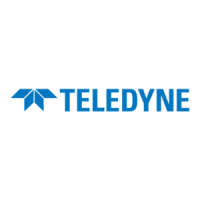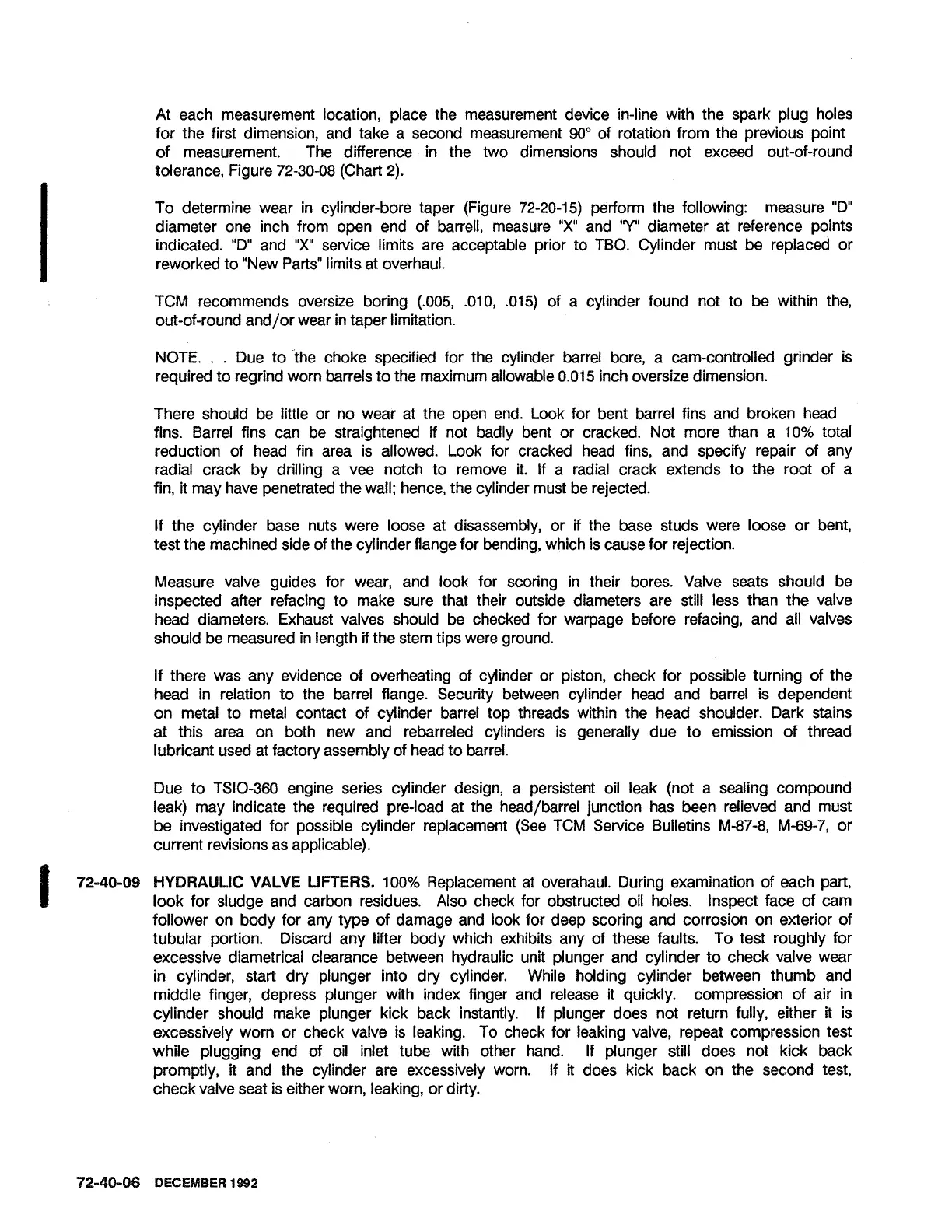At each measurement location, place the measurement device in-line with the spark plug holes
for the first dimension, and take a second measurement
90"
of rotation from the previous point
of measurement. The difference in the two dimensions should not exceed out-of-round
tolerance, Figure
72-30-08 (Chart
2).
To determine wear in cylinder-bore taper (Figure 72-20-15) perform the following: measure "D"
diameter one inch from open end of barrell, measure
"X
and
"Y"
diameter at reference points
indicated.
"D" and
"X
service limits are acceptable prior to TBO. Cylinder must be replaced or
reworked to "New Parts" limits at overhaul.
TCM recommends oversize boring
(.005, .010, .015) of a cylinder found not to be within the,
out-of-round and/or wear in taper limitation.
NOTE.
. .
Due to the choke specified for the cylinder barrel bore, a cam-controlled grinder is
required to regrind worn barrels to the maximum allowable 0.015 inch oversize dimension.
There should be little or no wear at the open end. Look for bent barrel fins and broken head
fins. Barrel fins can be straightened if not badly bent or cracked. Not more than a 10% total
reduction of head fin area is allowed. Look for cracked head fins, and specify repair of any
radial crack by drilling a vee notch to remove
it.
If a radial crack extends to the root of a
fin, it may have penetrated the wall; hence, the cylinder must be rejected.
If the cylinder base nuts were loose at disassembly, or
if
the base studs were loose or bent,
test the machined side of the cylinder flange for bending, which is cause for rejection.
Measure valve guides for wear, and look for scoring in their bores. Valve seats should be
inspected after
refacing to make sure that their outside diameters are still less than the valve
head diameters. Exhaust valves should be checked for
warpage before refacing, and all valves
should be measured in length
if
the stem tips were ground.
If there was any evidence of overheating of cylinder or piston, check for possible turning of the
head in relation to the barrel flange. Security between cylinder head and barrel is dependent
on metal to metal contact of cylinder barrel top threads within the head shoulder. Dark stains
at this area on both new and rebarreled cylinders is generally due to emission of thread
lubricant used at factory assembly of head to barrel.
Due to
TSIO-360 engine series cylinder design, a persistent oil leak (not a sealing compound
leak) may indicate the required pre-load at the
head/barrel junction has been relieved and must
be investigated for possible cylinder replacement (See TCM Service Bulletins M-87-8, M-69-7, or
current revisions as applicable).
72-40-09 HYDRAULIC VALVE LIFTERS.
100% Replacement at overahaul. During examination of each part,
look for sludge and carbon residues.
Also check for obstructed oil holes. Inspect face of cam
follower on body for any type of damage and look for deep scoring and corrosion on exterior of
tubular portion.
Discard any lifter body which exhibits any of these faults. To test roughly for
excessive diametrical clearance between hydraulic unit plunger and cylinder to check valve wear
in cylinder, start dry plunger into dry cylinder.
While holding cylinder between thumb and
middle finger, depress plunger with index finger and release it quickly.
compression of air in
cylinder should make plunger kick back instantly.
If plunger does not return fully, either
it
is
excessively worn or check valve is leaking. To check for leaking valve, repeat compression test
while plugging end of oil inlet tube with other hand. If plunger still does not kick back
promptly,
it
and the cylinder are excessively worn. If
it
does kick back on the second test,
check valve seat is either worn, leaking, or dirty.
72-40-06
DECEMBER 1992

